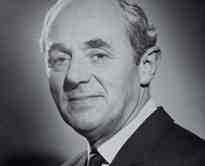Terry Miller (engineer)
| Terry Miller | |
|---|---|
 | |
| Born |
21 August 1911 Barnet, Middlesex, England |
| Died |
1989 (aged 77–78) Hertfordshire, England |
| Nationality | British |
|
Engineering career | |
| Engineering discipline | Locomotive engineer |
| Employer(s) | London and North Eastern Railway, British Rail |
| Significant projects | InterCity 125 |
Terence Charles Barry Miller, MBE (21 August 1911 – 1989) was a British railway engineer who rose to become Chief Engineer (Traction & Rolling Stock) for British Rail.[1]
Career
Miller began his career with the London and North Eastern Railway (LNER) as an apprentice, working under Sir Nigel Gresley. He rose up the ranks of LNER and continued his career under British Rail (BR) after nationalisation. In the New Year Honours list of 1956, he was awarded the MBE; he was at that time the Assistant Motive Power Superintendent of British Railways Eastern region.[2] By the 1960s, when BR was withdrawing steam locomotives and dismantling facilities for them, Miller was one of several people who provided support to Alan Pegler in his attempts to run the preserved LNER Class A3 4472 Flying Scotsman.[3]
He was appointed Chief Engineer (Traction & Rolling Stock) in 1968. It was in this position that Miller was credited with instigating the development of the InterCity 125, known as the High Speed Train (HST). At the time, BR was focused on developing an electric Advanced Passenger Train (APT), but by 1969 the APT project was significantly behind schedule. As a stop-gap measure, engineers devised plans for a 125-mile-per-hour (200 km/h) "High Speed Diesel Train", which Miller submitted to the British Railways Board (BRB) at the beginning of 1969; the submission won the endorsement of Sir Henry Johnson, chairman of BRB. The HSDT eventually became the InterCity 125, introduced into service from 1975. Although the HST was intended to fill in for the APT, the APT project was eventually abandoned and the HST remains in regular service as of 2014.[4][5]
Miller retired in 1973, three years before the HST entered service. He died in 1989.[1]
Legacy
In 2008, East Midlands Trains (EMT) named an HST power car, 43048, "T.C.B. Miller MBE" in his honour. The managing director of EMT, Tim Shoveller, described Miller as "a true giant in the history of the railway".[1]
In 2013, the 125 Group, an enthusiast group dedicated to the HST, launched "Project Miller", named in Miller's honour. The project was founded with the intention of bringing the remaining prototype HST power car, number 41001, back to working order after years of static display in the National Railway Museum in York.[6]
References
- 1 2 3 "East Midlands Trains unveils first reliveried HST and names a powercar 'Terry Miller MBE'". East Midlands Trains. 30 April 2008. Retrieved 23 September 2014.
- ↑ The London Gazette: (Supplement) no. 40669. p. 19. 2 January 1956.
- ↑ Roden, Anrew (2011). Flying Scotsman: The Extraordinary Story of the World's Most Famous Train. Aurum Press. ISBN 9781845137519.
- ↑ Morse, Greg (2013). British Railways in the 1970s and 80s. Oxford: Shire Publications. ISBN 9780747814092.
- ↑ Marsden, Colin (2001). HST: Silver jubilee. Hersham, Surrey: Ian Allan Publishing. pp. 10–11. ISBN 9780711028470.
- ↑ "About Us". Project Miller (125 Group). Retrieved 23 September 2014.